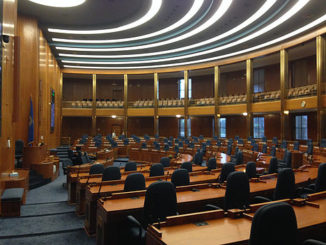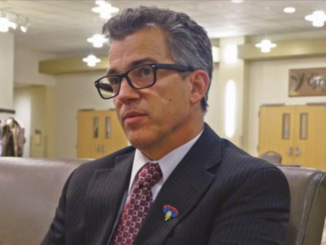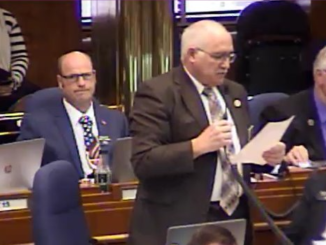
A proposal to change the way in which the building and maintenance of K-12 schools in the state are done is set to be considered by the North Dakota State Legislature. Former Speaker of the House, Rep. Larry Bellew (R – District 38), has introduced House Bill 1525, which — if passed — would provide real property tax relief without a tax increase.
Most North Dakotans probably aren’t familiar with it, but the Board of University and School Lands (also known as the Land Board) manages something called the Common Schools Trust Fund. As explained by the State Treasurer’s website:
“On February 22, 1889, Congress passed ‘An act to provide for the division of Dakota Territory into two states, and to enable the people of North Dakota, South Dakota, Montana and Washington to create their own constitutions and state governments.’ This Act is commonly known as the Enabling Act. Section 10 of this act granted sections 16 and 36 of every township of the new states to be used ‘for the support of the common schools.’ In cases where portions of section 16 and 36 had been sold prior to statehood, indemnity or ‘in-lieu’ selections were allowed. In North Dakota, this grant totaled more than 2.5 million acres.
…
“Several revenue sources contribute to the principal balance of this fund. It earns cash rents from leases of individuals using the lands for production agriculture, sales of the land, leasing of mineral rights, royalties and bonus payments from the production of minerals, and 10% of the Oil Extraction Taxes collected by the state.”
As of June 30, 2018 the balance of the Common Schools Trust Fund was $4,318,989,728. Yes, that’s over $4.3 billion. And the fund is growing rapidly— the to tune of about $400 million or more annually. A press release from the Department of Public Instruction in November put the fund at “more than $4.5 billion”.
In a nutshell, HB 1525 proposes three things:
- Use Common School Trust funds to retire outstanding common school bonds.
“The board of university and school lands shall identify all outstanding school bonds encumbering common schools in the state. Notwithstanding any other provision of law, school districts shall transfer all real property of the school district to the board of university and school lands. The board of university and school lands shall accept the real property of all school districts and shall retire any outstanding related debt.” - Fund all new and/or expanded common school real property facilities from the assets in the common school trust.
“To be eligible for new building construction and renovation of existing school district real property under this section, the board of a school district shall obtain the approval of the superintendent of public instruction for the building project… and submit a completed application to the board of university and school lands. The board of university and school lands, in consultation with the superintendent of public instruction, shall review construction and renovation application… If the new building construction or renovation project is approved by the superintendent of public instruction and the board of university and school lands, the board of university and school lands shall provide funding for the construction or renovation project and shall take ownership of the real property.” - Provide for facility maintenance and upkeep for all common school facilities using Common School Trust funds.
“The board of university and school lands annually shall provide for the maintenance of existing common school facilities, including the land on which the facilities are constructed.”
As you can tell, because of the way the bill is written, once the Land Board retires the bonds they are then obligated to remove levies upon all “real property” for school building funds. In other words, those pesky school bonds — that they float over and over again until they wear voters down — would be gone. And not only that, but all future maintenance of these schools would rest with the state.
I should also point out that in no way is the Common Schools Trust Fund related to the Legacy Fund. These are two separate and distinct funds. This bill has nothing to do with the Legacy Fund— or any other fund for that matter.
As it stands now, over 95% of the Common Schools Trust funds are invested in Wall Street. In 2017 alone, North Dakota paid Wall Street fund managers over $18.3 million in commission and management fees. In fact, over the course of the last ten years, the state has paid over $100 million in these fees.
Undoubtedly, the opposition to this bill is going to say that this is a loss of “local control”. As I wrote yesterday, local control is a myth. This flow chart from the North Dakota Department of Public Instruction (DPI) actually proves it. As you can see, anything over $150,000 requires approval from — you guessed it — the state. And once the approval is granted, the district has to mount a campaign to gain approval from the voters. It seems to me that the state has control and property owners foot the bill. That’s not much local control if you ask me. And let’s not forget that school bonds are in actuality legalized plunder of property owners.
Article VIII, Section 2 of the State Constitution is actually very clear on this issue:
“The legislative assembly shall provide for a uniform system of free public schools throughout the state, beginning with the primary and extending through all grades… .” (Emphasis Added)
Article X, Section 1 indicates that:
“The legislative assembly shall be prohibited from raising revenue to defray the expenses of the state through the levying of a tax on the assessed value of real or personal property… .” (Emphasis Added)
And let’s not forget Article VIII, Section 5:
“All… educational institutions, for the support of which lands have been granted to this state, or which are supported by a public tax, shall remain under the absolute and exclusive control of the state.” (Emphasis Added)
You see, it seems to me that the state has all the control, but they’re not providing all the funding— as the constitution mandates they do. HB 1525 would be a significant step in changing that by aligning the state with its constitutional mandate to “provide for a uniform system of free public schools throughout the state”.
I suppose the response to all of this might be, “But we don’t want to seek permission from the state when we have building needs.” Well, as I mentioned earlier— schools already do. “But we don’t want to be put in a position of begging for money,” might be the rejoinder. Again, as I mentioned earlier— schools already do that too.
I’ll remind you that the Land Board is comprised of:
- Governor Doug Burgum
- Secretary of State Al Jaeger
- Superintendent of Public Instruction Kirsten Baesler
- State Treasurer Kelly Schmidt
- Attorney General Wayne Stenehjem
You’ll notice that each one is an elected official. Do you suppose any of them would want to face voters who thought them to be responsible for not properly funding the building and maintenance needs of schools throughout the state? Let’s not forget that K-12 is a sacred cow of sorts in Bismarck.
There’s little question that serious changes are needed when it comes to education in North Dakota. I’d love to strip control of it away from the state. But that’s a tall order when we’re talking about changing the State Constitution. And besides, we must take one step at a time. Having said that, the very least we can do under the current circumstances is to remove this unfair and unnecessary burden from the backs of property owners.
(Note: If you’re interested in reading more from The Minuteman on North Dakota’s unconstitutional mechanism for funding education, you can click here.)
PLEASE LIKE & SHARE
Sources:
- https://www.legis.nd.gov/assembly/66-2019/documents/19-0868-02000.pdf
- https://land.nd.gov/
- https://www.nd.gov/treasurer/?id=79
- https://bismarcktribune.com/news/local/education/common-schools-trust-fund-continues-to-increase/article_43479eed-18bd-577b-a635-e09bf3990533.html
- https://www.nd.gov/dpi/SchoolStaff/ICR/press_releases/BaeslerPraisesIncreasedTrustFundSupportforNDSchools/
- https://theminutemanblog.com/2019/01/16/nd-house-education-committee-gives-local-control-bill-do-not-pass/
- https://www.nd.gov/dpi/uploads/143/SchoolConstructionFlowchart.pdf
- https://theminutemanblog.com/2017/02/13/school-bond-votes-legalized-plunder-of-property-owners/
- https://theminutemanblog.com/2017/12/28/is-property-tax-an-unconstitutional-funding-mechanism-for-education/





